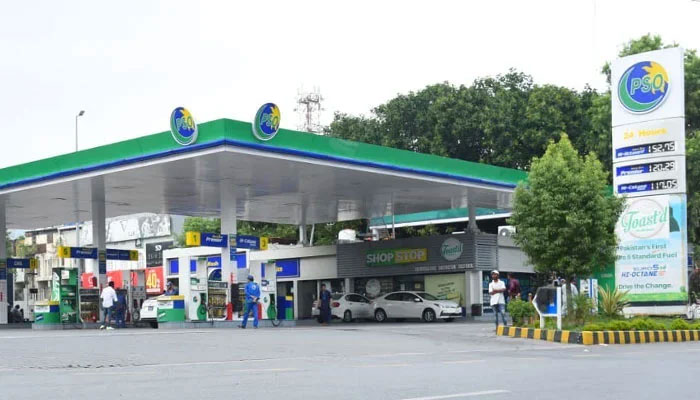PSO targets receivables as profit rises 14pc
KARACHI: Pakistan State Oil’s (PSO) total receivables stood at Rs732 billion by the end of March in the current fiscal year, including Rs325 billion in principal from SNGPL alone.
The figure was shared during a corporate briefing session on Friday, where the company’s management discussed its financial performance and outlook.Management noted that efforts to resolve the circular debt issue are ongoing, although no definitive plan is in place. The company aims to recover both principal and Late Payment Surcharge (LPS), which currently totals over Rs200 billion. Investment plans are ready but contingent on liquidity, with multiple options still under review.
Since February 2024, there has been no further build-up in circular debt from SNGPL, as the company has committed to monthly payments. “This understanding is continuing and being implemented in true spirit,” the management said. In contrast, receivables from OGDC and PPL increased in the third quarter due to delayed payments from Sui companies.
The management also indicated that an increase in margins on petroleum products is due, though the timeline remains uncertain. A margin increase in the upcoming fortnight appears unlikely given rising global oil prices amid tensions in the Middle East.
During the year, PSO added 67 new retail outlets and expanded its storage capacity. The company operates over 3,600 outlets nationwide, including 31 company-operated stations, and has 9 installations, 19 depots, and 15 aviation stations across the country. Retail expansion will remain a focus in the coming years.
Fuel smuggling continues to pose a challenge, ranging between 1,500 and 6,000 tonnes per day, with daily averages typically between 2,000 and 3,000 tonnes depending on weather and enforcement activity.
The management noted a decline in PSO’s market share compared to the previous year, attributing it to aggressive discounting by other OMCs, which PSO deemed unsustainable. Despite last year’s abnormal trends, the company’s realistic market share stands at 45-46 per cent, with plans to strengthen its position organically.
Digital payments account for 12-13 per cent of PSO’s transactions, including those made via PSO and bank cards, compared to 9-10 per cent for other industry players.
The company’s total storage capacity stands at approximately 1.24 million tonnes, following the easing of certain Ogra restrictions. PSO also operates two lubricant manufacturing facilities with a single-shift blending capacity of 70,000 metric tonnes per annum.
Infrastructure development included the construction of two 25,000 MT tanks at the Faqirabad depot and the rehabilitation of four tanks (5,300MT) at KTB, DLP, and LMPA.
The management reported that the decline in international fuel prices -- from $85.03/bbl in 9MFY24 to $76.43/bbl in 9MFY25 -- resulted in inventory losses. Nevertheless, PSO recorded a 14 per cent year-on-year profit increase, reaching Rs15 billion in 9MFY25.
In the same period, Pakistan’s liquid fuel mix shifted towards mogas (48.3 per cent) and HSD (41.9 per cent), while furnace oil dropped to 5.0 per cent (from 8.4 per cent) and JP-1 remained steady at 4.3 per cent. PSO mirrored this trend, with mogas and HSD rising to 44 per cent and 43.7 per cent respectively, furnace oil declining to 1.9 per cent (from 4.2 per cent), and JP-1 increasing to 9.6 per cent (from 8.5 per cent).
-
 King Charles’ Plans The Biggest Risk Of His Cancer-stricken Years And Its Not For Prince Harry
King Charles’ Plans The Biggest Risk Of His Cancer-stricken Years And Its Not For Prince Harry -
 Beyonce Hid Early Pregnancy While Delivering 'one Of Her Hardest Shows', Discloses Mom Tina Knowles
Beyonce Hid Early Pregnancy While Delivering 'one Of Her Hardest Shows', Discloses Mom Tina Knowles -
 Nicole Kidman And Keith Urban’s Monthly Salaries Disclosed Amid Divorce
Nicole Kidman And Keith Urban’s Monthly Salaries Disclosed Amid Divorce -
 Alix Earle 'tested The Waters' With Tom Brady At New Year Bash, Decodes Expert
Alix Earle 'tested The Waters' With Tom Brady At New Year Bash, Decodes Expert -
 Disney Announces Lead Actors For Live-action Tangled Remake
Disney Announces Lead Actors For Live-action Tangled Remake -
 Prince Harry’s Personal Desire Is Throwing A ‘provocative & Extreme Strain’ With Meghan Markle
Prince Harry’s Personal Desire Is Throwing A ‘provocative & Extreme Strain’ With Meghan Markle -
 Jennifer Garner Admits What Makes Coparenting With Ben Affleck 'hardest'
Jennifer Garner Admits What Makes Coparenting With Ben Affleck 'hardest' -
 Ethan Hawke Shares Next Film Will Become The 'greatest Ever'
Ethan Hawke Shares Next Film Will Become The 'greatest Ever' -
 Jimmy Kimmel Fires New Shots At US President Donald Trump
Jimmy Kimmel Fires New Shots At US President Donald Trump -
 Ethan Slater Draws Firm Line On Sharing Details About His Son
Ethan Slater Draws Firm Line On Sharing Details About His Son -
 Kate Middleton Is Going Against Old Guards And Camilla: ‘It’s Not Long Till She’s Queen’
Kate Middleton Is Going Against Old Guards And Camilla: ‘It’s Not Long Till She’s Queen’ -
 Drew Barrymore Shares Why Her 'sardines' Tattoo Is Deeply Personal
Drew Barrymore Shares Why Her 'sardines' Tattoo Is Deeply Personal -
 Jennifer Garner Gets Honest About Ben Affleck Split: 'True Partnership' Lost
Jennifer Garner Gets Honest About Ben Affleck Split: 'True Partnership' Lost -
 Joe Jonas 'getting Serious' With Tatiana Gabriela: Source
Joe Jonas 'getting Serious' With Tatiana Gabriela: Source -
 Kate Middleton's 44th Birthday Coincides With Significant Meghan Anniversary
Kate Middleton's 44th Birthday Coincides With Significant Meghan Anniversary -
 Queen Camilla Turns Territorial And Panicked Seeing Ruthlessness
Queen Camilla Turns Territorial And Panicked Seeing Ruthlessness




